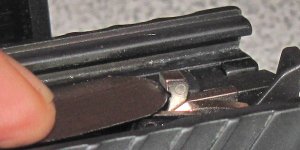The play in the rails is what allows movement that affects sear engagement.
Sear engagement is affected by any play between the "sear" and the striker. That play can be caused by vertical movement of the slide relative to the frame, relative to the fire control unit, or maybe relative only to the sear, depending on how the gun is constructed and where the play exists.
In other words, even if there were no play at all between the slide and the rails, if, for some reason, there were play between the slide and fire control unit (e.g. the fire control unit fits loosely to the unit which incorporates the rails) that would still affect sear engagement.
To be clear, I don't think that's what's happening here, I was just responding to your question about the possibility of "movement ... between the fire control unit ... and the frame".
... recoil would occur before the movement was noticeable during live fire.
I agree. There's no way this would be noticed during live fire.
I measured the distance between the back of the slide and each grip module ("frame"): with the striker cocked and released and, for each of those conditions, with and without a magazine in the pistol.
Interesting results. 0.006" is not a lot of play.
https://gastatic.com/blog/wp-content/uploads/2015/02/Sig-P320-internal-safety.png
From the picture in the link, it appears that the sear and striker engagement surface are slightly slanted which means that when they are engaged, there's a downward force on the striker (and anything it's attached to). It also means that they are unlikely to come out of engagement with each other once they're engaged.
I placed a 0.006" feeler gauge (the amount of movement) next to the striker's sear engagement surface; a 0.006" movement would be a small fraction of the striker's sear engagement surface.
I doubt that the full surface is actually engaged. In the Glock design, for example, the actual engagement is usually only around 70% of the total possible.


